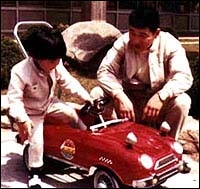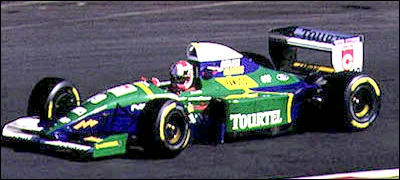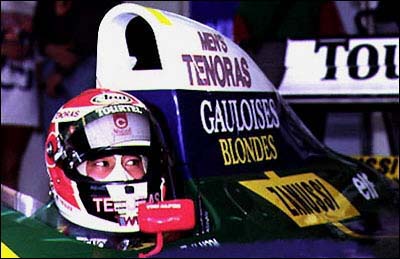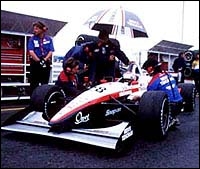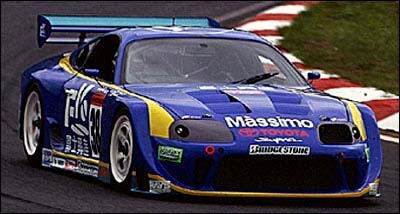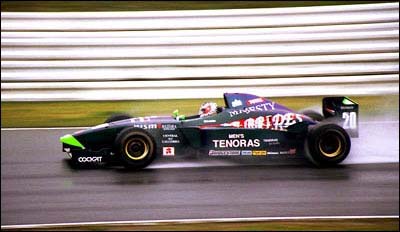| BEFORE FORMULA ONE | ||
|
1982-85
Champion in several kart series |
While Satoru Nakajima seems to be credited as the pioneering Japanese driver on the international racing stage, the ever-smiling
Hideki Noda, born in Osaka on 7 March 1969, has also been responsible for a fair share of firsts for Japanese drivers.
He began his motor racing career in the tradition way, through karting. In 1982 he competed in the Kansai Kart Land J-class category, where he was champion. He then took the Japanese National A-1 class championship the next year, and won the Japanese National A-1 West Division series in 1985. |
|
|
1986-89
Makes the move from Japan to Europe, adjusts quickly |
Moving up to the A-2 class for 1986, he was Japanese champion again, before going to Japanese Formula Junior 1600 for 1987, where he won 4 times and was the top rookie. A year there was enough, and for 1988 Noda was in the competitive world of Japanese F3. Having raced in that for a year, including the end-of-season trip to Macau, and harbouring ambitions of F1, by 1989 he was on his way to Europe.
He adjusted very quickly indeed, on and off the track. In British Formula Vauxhall Lotus in 1989, he was 5th overall, with a win at Donington, plus two 3rd places at Donington and Mondello Park in Ireland. In the GM Lotus Euroseries, he came 9th, with 2nd places at Paul Ricard and Zandvoort. |
|
|
|
||
|
1990-92
Landmark F3 win, attempts International F3000 |
For the next two years after that, Noda raced in British F3 in a Ralt. After a learning year in 1990, when he came 14th overall, in 1991 he improved to 7th, with a win at Silverstone. This was the first time that a Japanese driver had won in F3 outside the land of the rising sun.
Not one for hanging around, by 1992 he was in International F3000 for the 3001 team, but in a difficult first season he failed to score any points. Instead, he racked up 2 accidents and a spin, plus a DNQ at Hockenheim - his best result an 8th at Mangy-Cours. This was the final round, his results had improved as the season had progressed. |
|
|
1993-94
9th in competitive championship a good showing |
1993 was better, in a TOM's Reynard 93D, using both a Cosworth and Matsuura engine. Though he again failed to score points, there were signs of improvement. He only retired twice in 8 rounds with a best finish of 9th at Pau. This time, however, his season tailed off a bit.
1994, he joined the Forti Corse team in a Reynard Cosworth 94D, as team-mate to Pedro Diniz. The team stunned everyone at the Silverstone opener, qualifying 4th (Noda) and 6th (Diniz). Noda went on to finish 5th. He added a 3rd at Enna, and he also qualified 5th twice, and 6th once. He ended up equal 9th, which was not bad at all. |
|
| FORMULA ONE | ||
|
|
||
|
1994 Larrousse Great things were not expected of him, despite previous success |
However, it was by virtue of the sponsorship money he had behind him that he bought his way into the financially woeful Larrousse F1 team at the end of the 1994 season. His results in F3000 should have suggested that he could do OK, but, as Noda said himself: "People think I'm useless."You said it, Hideki! Joining Erik Comas in the struggling LH94 chassis, using Cosworth V8 engines, for the 14th round at Jerez, there were fears that both he and fellow newcomer Mimmo Schiattarella would not beat Bertrand Gachot's Pacific for the last grid spot. |
|
|
1994
Pulls greater g-forces than teammate Comas |
But Noda got in easily, qualifying 24th, a spot and less than a second behind Comas, and ahead of David Brabham's Simtek. More interestingly than that, he was pulling 4.1g under braking, a Larrousse record. Usually new F1 drivers take a while to make full use of the brakes.
Considering that Comas usually pulled less than 3g, Noda had adjusted very quickly indeed. Yet his debut race got off to a disastrous start, when he stalled on the grid. He had company, though, in the form of none other than countryman Ukyo Katayama. |
|
|
1994
Debut race an eventful one - first a stall, then a smash with ol' Nige |
But while Katayama proceeded to storm back through the field to finish a mighty 7th, Noda finally got going but could do no more than tour at the back. However, worse was to come. After 10 laps, he began to suffer a terminal gearbox problem and limped back to the pits. As he did so, a front-running bunch came up to him, including
Rubens Barrichello's Jordan and a thoroughly unimpressive
Nigel Mansell in his Williams.
While Barrichello managed to dart around the Larrousse, Mansell locked his brakes and hit Noda, eventually forcing the Englishman to pit for a new nose, stuffing his race completely (and damaging Il Leone's reputation somewhat). Onya Hideki! |
|
|
|
||
|
1994
Monsoonal conditions envelope his home race |
If this was all difficult enough, the Japanese GP at Suzuka, his home race, would be even more catastrophic. Once again he qualified a spot behind Comas, this time in 23rd spot, but he was only 0.013 of a second behind the Frenchman. Once again he managed to outpace Brabham's Simtek. But come race day, there was torrential rain drenching the circuit, creating treacherous conditions.
Not that Noda would get to experience it much. He started from the pit lane, and couldn't even complete a single lap before his fuel injection system packed up. In what turned out to be a dreadful race for the entire Japanese contingent, both Katayama and Taki Inoue then aquaplaned into the pit wall (of all places) in separate incidents at the end of lap 3. |
|
|
1994
Thrashes teammate Deletraz, but his Larrousse only lasts 18 laps |
The last race in Adelaide was, by comparison, an improvement. This time he could easily beat his team-mate, but remembering that
Jean-Denis Deletraz had bought his way in place of Comas, Noda's achievement wasn't that special! But, for the third time running, Noda had the better of the Simteks, qualifying 23rd once again.
However a poor start saw both Brabham and Schiattarella get past him, and after 18 laps Noda was gone anyway with an oil leak. Larrousse folded after 1994, but Noda wasn't in the hunt for a drive with them for 1995 anyway (let's face it: who would?). |
|
|
1995 Simtek A wasted year thanks to Simtek deal and Kobe earthquake |
Instead, he had done a deal with Simtek to drive as Jos Verstappen's team-mate in the second half of the 1995 season, with Schiattarella to do the first half. But as fate would have it, Noda's funds took a battering after the devestating earthquake in his home town of Kobe. Simtek nonetheless took his deposit.
Nick Wirth's team then proceeded to close after Monaco, and Noda never got to sit in the car, but forfeited his deposit for his troubles. With that, his 1995 was completely wasted. |
|
|
|
||
| AFTER FORMULA ONE | ||
|
|
||
|
1996-97
Mixes it with some big names in IndyLights |
For 1996, with no F1 options open to him, Noda went across the Atlantic to compete in Indy Lights. Again he showed his versatility and adaptability by finishing 3rd at Toronto. Staying in the category in 1997, he drove for the Indy Regency team as team-mate to Mexican driver Rodolfo Lavin.
Amongst his rivals that year were current CART stars Cristiano da Matta, Tony Kanaan, Helio Castro Neves and Luiz Garcia Jr, current IRL drivers Airton Dare, Jaques Lazier and Jeff Ward, and other notable racers including Robby Unser, Canadian John Jones, F1 Reject Naoki Hattori, Shigeaki Hattori and Christophe Tinseau. |
|
|
1997
Makes his mark more toward the end of the season |
Though Castro Neves and Da Matta took three wins apiece, and Kanaan only one, Kanaan's consistency saw him take the title.
Noda, though, did reasonably well. He was usually in and around the midfield, but had two excellent results in particular.
Towards the end of the season he qualified 2nd and finished 3rd at Vancouver, but it was at Portland that he really starred. There he also qualified 2nd, and on race day it rained. I don't know if qualifying was in the rain, but at least for the race he could put his European experience to good use. |
|
|
|
||
|
1997
Takes historic victory in rain-shortened affair |
Dicing with Castro Neves for most of the race, he passed him on lap 22. When the race was stopped on lap 29, Noda was declared the winner. It was the first time a Japanese driver has won a CART-sanctioned event, and the only time so far (though Takuya Kurosawa got close at the Long Beach CART round this year).
Those 7 laps that Noda led were his only laps at the front all season. He ended up 9th overall, with 51 points. Funny how his history making win was the result of a shortened race - and just 29 laps at that. Admittedly, though, he wasn't going anywhere in Indy Lights. Sure, he had done OK, but the talent scouts weren't looking at him. |
|
|
1998
Returns to Japan in F3000, but not exactly in a blaze of glory |
So for 1998 it was back to Japan to race in Formula Nippon. In the mandatory Lola T98-51 chassis with a Mugen engine, Noda had what he probably would have seen as an average season, considering his experience in International F3000, F1 and then Indy Lights.
He scored 5th places at Suzuka and Fuji, and a 6th at Motegi, before finishing 3rd at Sugo having started 4th and dropping back to 8th after going off the track on lap 14.
But apart from that, he also spun out of three separate races. 10th overall with 9 points was, in all honesty, a poor return. Maybe it had to do with adjusting back to life in Japan, having spent the previous nine years in Europe and America. |
|
|
|
||
|
1998-99
Adds the JGTCC to his schedule, new helmet can't help him in FNippon |
He also took up Japanese GT sports car racing that year with the FK team in the Massimo Cerumo Toyota Supra shared with H. Takeuchi. In a season marred by retirements, including a first lap DNF at Fuji, and another race at Fuji that was abandoned due to fog, the pairing recorded a best finish of 3rd at Sugo to place 11th overall.
In 1999, his Formula Nippon results weren't improving much, his best being a 6th at Suzuka and a 2nd at Mine. In fact, despite a brand new helmet design featuring, of all things, a waving Japanese flag (we wonder how on earth he came up with that idea), he slipped to a lowly 11th in the standings. |
|
|
1999
Joins Le Mans Tiger team with Aussie Wayne Gardner |
He also switched teams in Japanese sports cars, joining the Le Mans Esso Tiger Team under Koichiro Mori. With a striking tiger colour scheme for his Toyota Supra, he shared the car with 1987 500cc motorcycling World Champion and Australian V8 Supercar reject Wayne Gardner.
Competing in the top GT500 class, the season started off badly with an oil leak and fire at Sugo, but then the pair took 5th at Mine and victory at Fuji, plus another 5th place finish at the Fuji 1000kms endurance event. |
|
|
|
||
|
2000
Generally somewhat off the pace in both series |
The year 2000 has seen Noda continue in both categories for the Le Mans team. In Formula Nippon, he has again struggled in the midfield in his Reynard 99L, except for a fine 3rd place from 2nd on the grid at Mine.
In the Japanese GT championship, he and Gardner have so far notched up an 8th at Motegi, a 4th at Fuji having started 2nd, and a 7th at Sugo in their Supra. |
|
|
Personal
Favourite racing memory dicing with DC in F3; always has time for a milkshake |
On a personal note, Hideki is 1.7 metres tall, and weighs 63kg. He enjoys weight-training, running and swimming, and looks as though he has a penchant for dyeing his hair! Not surprising seeing as though he states fashion as a hobby, as well as squash and mountain-biking. He likes Japanese music, 'The Alfee' in particular, while his favourite drink is a milkshake, and he particularly enjoys pasta and spaghetti pomodoro with lots of parmeggiano.
Strangely, he says that one of his favourite moments in his motorsport career is when he diced with David Coulthard in only his second F3 race at Donington, before being punted off by a backmarker. Though he says that his ambition is to win in Formula One, it would seem as though that dream will never be fulfilled. At least he made it there. |
|
|
|
||
